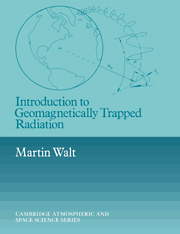Book contents
- Frontmatter
- Contents
- Preface
- List of symbols
- Useful constants
- Geophysical quantities
- Energy equivalents
- 1 The Earth's radiation belts
- 2 Charged particle motion in magnetic and electric fields
- 3 The geomagnetic field
- 4 Adiabatic invariants
- 5 Particle fluxes, distribution functions and radiation belt measurements
- 6 Particle diffusion and transport
- 7 Diffusion in pitch angle
- 8 Diffusion in the L coordinate or radial diffusion
- 9 Summary and comments
- Appendix A Summary of frequently used formulas
- Appendix B Gyration, bounce and drift frequencies in a dipole field
- References
- Index
9 - Summary and comments
Published online by Cambridge University Press: 21 September 2009
- Frontmatter
- Contents
- Preface
- List of symbols
- Useful constants
- Geophysical quantities
- Energy equivalents
- 1 The Earth's radiation belts
- 2 Charged particle motion in magnetic and electric fields
- 3 The geomagnetic field
- 4 Adiabatic invariants
- 5 Particle fluxes, distribution functions and radiation belt measurements
- 6 Particle diffusion and transport
- 7 Diffusion in pitch angle
- 8 Diffusion in the L coordinate or radial diffusion
- 9 Summary and comments
- Appendix A Summary of frequently used formulas
- Appendix B Gyration, bounce and drift frequencies in a dipole field
- References
- Index
Summary
From the principles described in the preceding chapters it is apparent that the presence of geomagnetically trapped radiation is inevitable, given the Earth's magnetic geometry, the sources of plasma in the Earth's atmosphere and solar wind, and the neutron albedo. That the outer planets of the solar system, those bodies with large magnetic dipole moments, also support radiation belts is additional evidence for the ubiquity of the particle trapping phenomena. However, the particular nature of a planet's radiation zones, the intensities, the spatial distributions, the types of particles and the energy spectra, will depend on characteristics unique to each planet. Individual planetary properties such as rotation rates, atmospheric compositions, distances from the sun, intrinsic magnetic moments, electric and magnetic fluctuations, and characteristics of plasma waves will influence the actual radiation belt that a planet can maintain.
In this regard a comparison of Earth's radiation belts with those of other planets is instructive. The solar system has a wonderful variety of radiation trapping planets whose different properties lead to unique features in their radiation belts. Venus and Mars have little or no intrinsic magnetic fields and therefore no radiation belts. Mercury has a small magnetic moment, but the distortion of its field by the solar wind precludes long-term trapping.
- Type
- Chapter
- Information
- Introduction to Geomagnetically Trapped Radiation , pp. 149 - 156Publisher: Cambridge University PressPrint publication year: 1994



